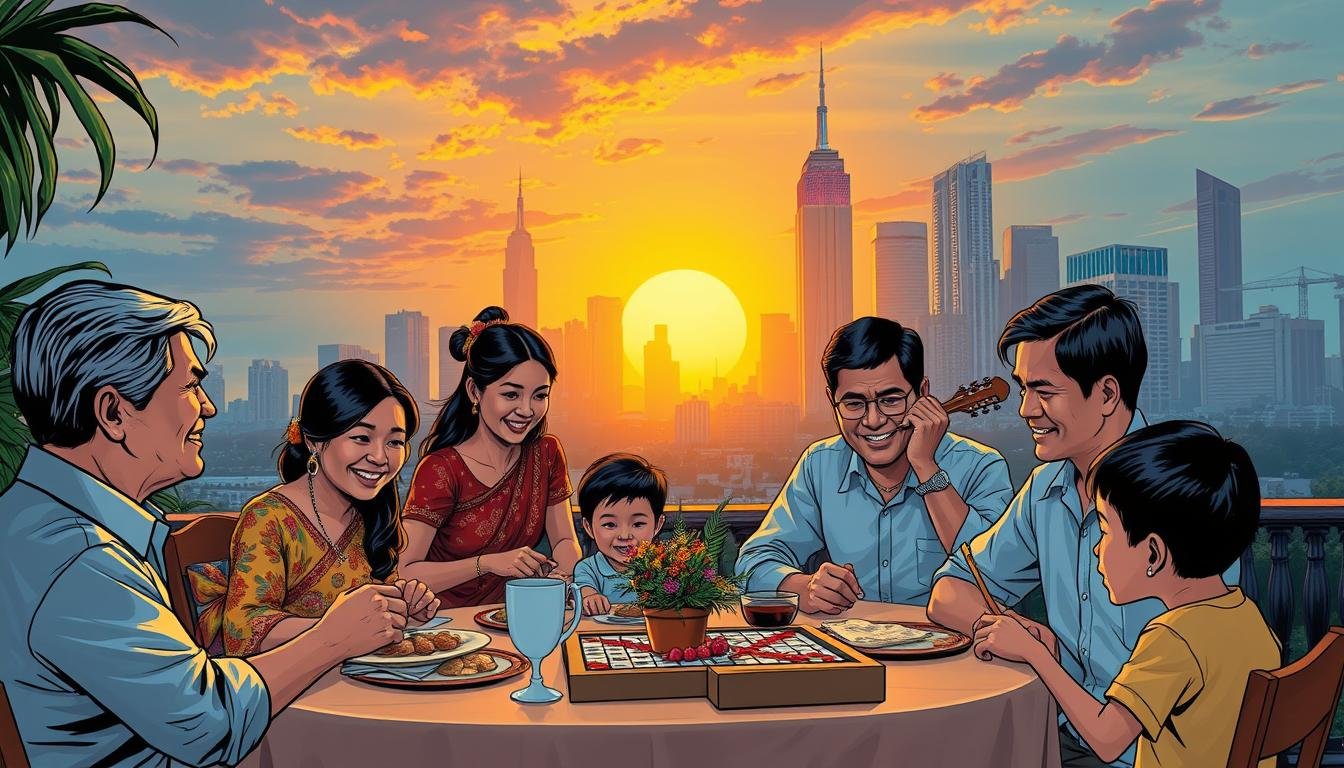American social practices have significantly shaped Filipino etiquette over the years. This influence stems from historical ties and the widespread consumption of American pop culture. Understanding these changes helps foster better cultural integration while preserving Filipino heritage.
Filipino society has always valued respect and harmony. The introduction of American customs has added new layers to these traditions. For example, the emphasis on individualism in American culture contrasts with the Filipino focus on community and family. Yet, both systems coexist, creating a unique blend of practices.
Adapting to these changes requires awareness and sensitivity. By recognizing the duty to respect both cultures, individuals can navigate social interactions more effectively. This guide aims to provide insights into blending traditions while maintaining cultural identity.
Key Takeaways
- American social practices have influenced Filipino etiquette significantly.
- Historical and cultural factors play a key role in this evolution.
- Understanding both cultures fosters better integration.
- Respect for traditions is essential in adapting to new customs.
- Blending practices helps maintain cultural heritage.
Introduction to American Social Customs and Filipino Etiquette
The blending of American social norms with Filipino traditions has created a unique cultural tapestry. This fusion is rooted in historical ties and the continuous exchange of ideas. Understanding this dynamic helps individuals navigate social interactions with greater ease and respect.

Purpose and Overview
This guide aims to provide a clear understanding of how American social practices have influenced Filipino etiquette. By exploring these changes, readers can better appreciate the value of cultural adaptation. The product of this exchange is a richer, more diverse social landscape.
Cultural importation is not just about adopting new practices. It’s about finding harmony between traditions. This guide will help you identify areas where American and Filipino customs align and where they differ.
How This Guide Helps You Adapt Traditions
Adapting to new social norms can be challenging. This guide offers practical steps to integrate American traditions into your lifestyle. Whether it’s understanding the importance of punctuality or embracing individualism, these insights will make the process smoother.
Think of cultural adaptation as an entry point to a broader perspective. By blending practices, you can maintain your cultural identity while embracing new ideas. Below is a table summarizing key areas of adaptation:
| American Custom | Filipino Tradition | Adaptation Strategy |
|---|---|---|
| Punctuality | Flexible time (“Filipino time”) | Balance punctuality in formal settings while maintaining flexibility in social gatherings. |
| Individualism | Community focus | Celebrate personal achievements while valuing family and community support. |
| Direct communication | Indirect communication | Use diplomacy in conversations to avoid causing offense. |
By following these strategies, you can create a harmonious blend of traditions. This guide is your roadmap to navigating cultural exchanges with confidence and respect.
Historical Context of American Influence
The historical ties between the United States and the Philippines have deeply influenced Filipino social norms. From the early 20th century, American policies and practices began to shape the cultural landscape of the Philippines. This influence was not just limited to social etiquette but extended to economic and regulatory frameworks.
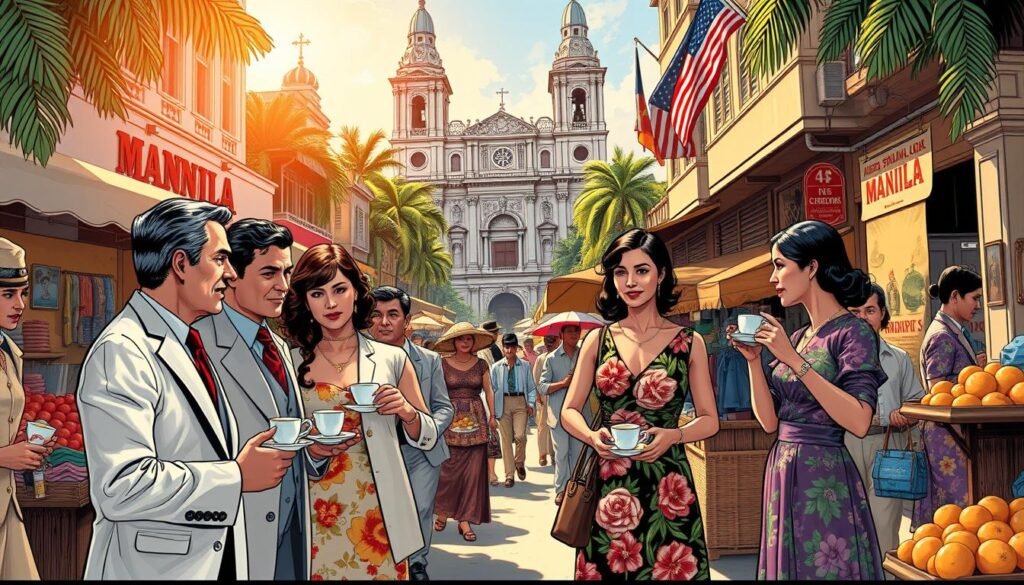
Early Cultural Exchanges
One of the earliest forms of American influence was through tariffs and trade policies. The U.S. imposed tariffs on goods entering the Philippines, which indirectly shaped local practices. For example, the introduction of American products led to changes in Filipino consumer behavior and social interactions.
Regulations also played a key role. American service systems, such as postal and transportation networks, were introduced in the Philippines. These systems not only improved infrastructure but also influenced how Filipinos communicated and conducted business.
Evolution Through Time
Over the decades, the influence of American culture evolved. The introduction of American education systems brought new ideas and values to the Philippines. Schools taught American history and English, which became a bridge for cultural exchange.
Another significant factor was the role of regulation in shaping societal norms. American laws and policies were adapted to fit the local context, creating a unique blend of traditions. For instance, the emphasis on individualism in American culture began to coexist with the Filipino focus on community.
Here’s a table summarizing key historical influences:
| American Influence | Impact on Filipino Etiquette |
|---|---|
| Tariffs on goods | Changed consumer behavior and social interactions |
| Service systems (postal, transportation) | Improved communication and business practices |
| Regulations and laws | Shaped societal norms and cultural integration |
Understanding this historical context helps us appreciate the depth of American influence on Filipino etiquette. It also highlights the importance of preserving cultural identity while embracing change.
Overview of Filipino Etiquette Traditions
Filipino etiquette is deeply rooted in values that have been passed down through generations. These traditions reflect a strong sense of community, respect, and harmony. Understanding these practices helps us appreciate the cultural richness of the Philippines.
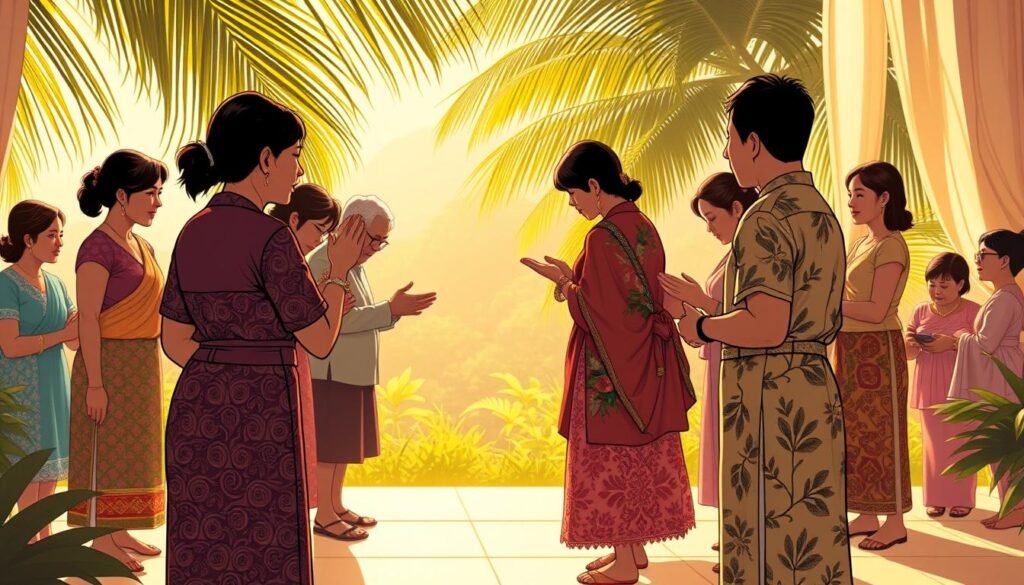
Core Cultural Values
At the heart of Filipino etiquette are values like hiya (shame), utang na loob (debt of gratitude), and pakikisama (harmonious relationships). These principles guide social interactions and foster a sense of belonging.
For example, hiya teaches individuals to act with humility and avoid causing embarrassment. Similarly, utang na loob emphasizes loyalty and reciprocity within families and communities.
Unique Filipino Practices
Filipino culture is rich with unique practices that set it apart. The mano po gesture, where younger individuals show respect to elders, is a cherished tradition. Another example is bayanihan, which symbolizes community cooperation.
Communal dining is also a key aspect of Filipino etiquette. Meals are often shared, and it’s polite to wait for the host to begin eating. These practices highlight the importance of togetherness and hospitality.
Just as tax and declaration processes ensure transparency, Filipino etiquette requires clear expressions of respect and gratitude. These values are declared through actions, reinforcing cultural identity.
| Practice | Description |
|---|---|
| Mano Po | A gesture of respect where younger individuals take an elder’s hand and place it on their forehead. |
| Bayanihan | Community cooperation, historically involving physical help, now symbolizing collective effort. |
| Communal Dining | Meals are shared, and it’s polite to wait for the host to begin eating. |
These traditions continue to influence modern etiquette, blending seamlessly with external influences. By preserving these practices, Filipinos maintain their cultural heritage while embracing change.
Analyzing American Social Customs in a Modern Context
Modern American social customs continue to shape daily life, reflecting both tradition and innovation. These practices are deeply embedded in societal norms, influencing everything from personal interactions to national identity. Understanding their role helps us appreciate their value in maintaining order and balance.
One key aspect is the role of authority in shaping societal rules. In the U.S., institutions like schools and workplaces enforce punctuality and direct communication. These practices parallel the broader societal emphasis on structure and efficiency.

The concept of country and national identity is also expressed through these customs. Holidays like Independence Day and Thanksgiving celebrate shared values and history. These traditions reinforce a sense of belonging and pride in being American.
Historically, customs were tied to survival and community. Today, they serve as a bridge between the past and present. For example, the emphasis on individualism now coexists with a growing appreciation for diversity and inclusion.
- Punctuality and time management are highly valued in professional settings.
- Direct communication fosters clarity but requires diplomacy in multicultural contexts.
- National holidays celebrate shared values, strengthening community bonds.
Modern practices also maintain societal balance. For instance, tipping in restaurants reflects gratitude and fairness. These small acts of etiquette contribute to a harmonious social fabric.
By analyzing these customs, we see how they evolve while preserving their core value. This balance ensures that traditions remain relevant in a rapidly changing world.
Understanding Social Norms: A Comparative Analysis
Understanding the differences and similarities between American and Filipino social norms is essential for fostering cross-cultural respect. By examining these practices, we can identify areas of alignment and divergence, which are crucial for developing culturally sensitive interactions.
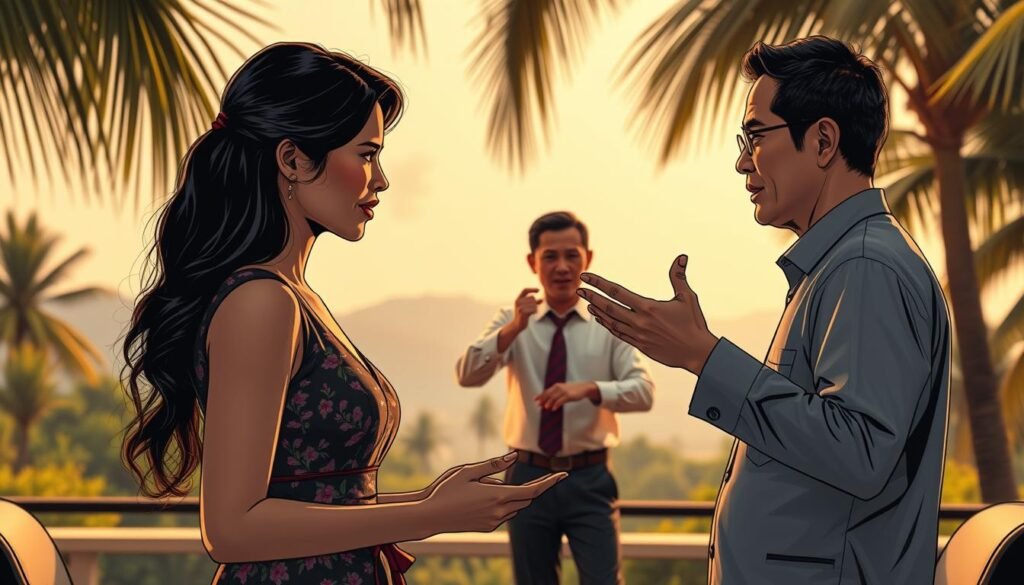
American Norms Versus Filipino Practices
American social norms emphasize individualism, punctuality, and direct communication. These values are deeply rooted in the country’s history and government policies. For example, the U.S. education system promotes self-reliance and personal achievement, which contrasts with the Filipino focus on community and family.
In the Philippines, social practices are guided by values like hiya (shame) and utang na loob (debt of gratitude). These principles foster harmonious relationships and mutual respect. The government also plays a role in shaping these norms through policies that promote cultural preservation.
Similarities and Key Differences
Both cultures value respect and hospitality, but their expressions differ. For instance, Americans often show respect through direct communication, while Filipinos use indirect methods to avoid causing offense. These differences highlight the importance of understanding cultural context.
Another key difference lies in the role of information dissemination. In the U.S., clear and transparent communication is prioritized, whereas in the Philippines, diplomacy and tact are emphasized. These variations can lead to misunderstandings but also offer opportunities for learning and adaptation.
| Aspect | American Norms | Filipino Practices |
|---|---|---|
| Communication | Direct and clear | Indirect and diplomatic |
| Time Management | Punctuality is crucial | Flexible time (“Filipino time”) |
| Social Structure | Individualism | Community focus |
Here are some key takeaways from this comparative analysis:
- American norms emphasize individualism and direct communication.
- Filipino practices prioritize community and indirect communication.
- Both cultures value respect but express it differently.
- Understanding these differences fosters cross-cultural sensitivity.
By examining specific cases, such as workplace interactions or social gatherings, we can better appreciate the nuances of each culture. This structured comparison helps individuals navigate cultural exchanges with confidence and respect.
Exploring the Role of Customs in International Trade and Culture
The regulatory functions of customs agencies play a pivotal role in shaping international trade and cultural exchanges. These agencies ensure that goods move smoothly across borders while maintaining national security and economic stability. Their influence extends beyond commerce, impacting cultural integration and societal norms.
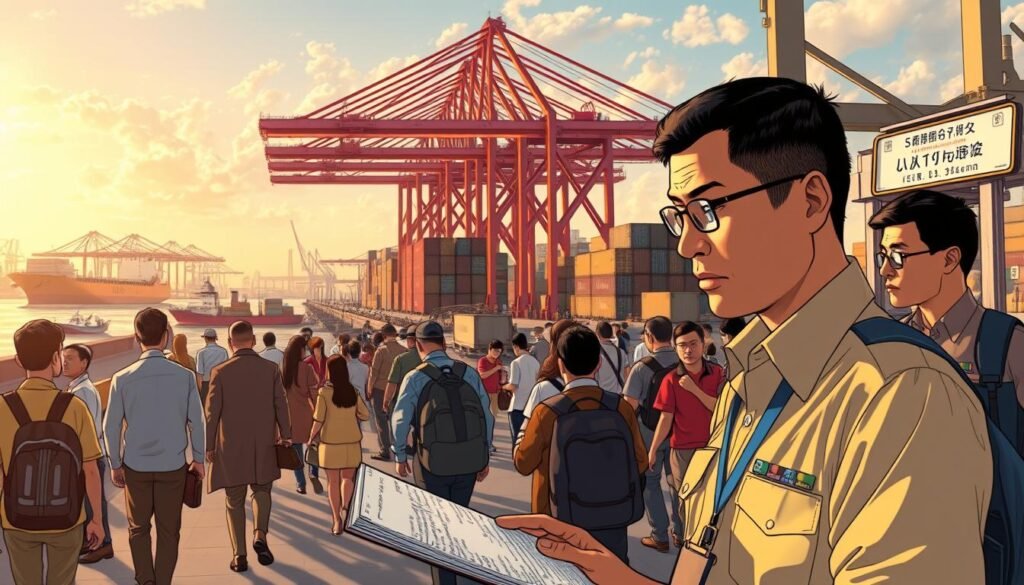
In the modern era, customs agencies have embraced technology to streamline processes. Innovations like digital clearance and blockchain enhance efficiency and transparency. These advancements are particularly crucial in fostering trust and collaboration between nations.
Customs and Their Regulatory Impact
Customs agencies operate in diverse areas, each with unique challenges and opportunities. Their regulatory practices are shaped by the specific needs of the region they serve. For example, in the Philippines, customs policies balance economic growth with cultural preservation.
One key function of these agencies is enforcing national laws on imports and exports. They ensure compliance with tariffs, duties, and trade agreements. This regulatory framework protects local industries while promoting fair competition.
Technology plays a vital role in modern customs operations. Automated systems reduce human error and speed up processing times. This efficiency is essential for maintaining a competitive edge in global trade.
The Intersection of Trade, Duty, and Etiquette
Trade and culture are deeply interconnected. Customs agencies not only regulate commerce but also facilitate cultural exchanges. For instance, they oversee the import of art and literature, enriching national heritage.
The concept of duty extends beyond financial obligations. It includes respecting the cultural values of trading partners. This mutual respect fosters stronger international relationships and smoother transactions.
Here’s a table summarizing key regulatory practices and their cultural impact:
| Regulatory Practice | Cultural Impact |
|---|---|
| Tariff Enforcement | Protects local industries and promotes fair trade. |
| Digital Clearance | Enhances transparency and efficiency in cross-border transactions. |
| Cultural Exchange Oversight | Preserves and enriches national heritage through art and literature. |
By understanding the role of customs agencies, we can appreciate their contribution to both trade and culture. Their efforts ensure that global exchanges are conducted with respect and efficiency.
Adapting American Traditions into Filipino Lifestyles
Integrating American traditions into Filipino lifestyles requires a thoughtful approach. This process involves balancing new practices with existing cultural values. By following structured methods, individuals can achieve a harmonious blend of traditions.
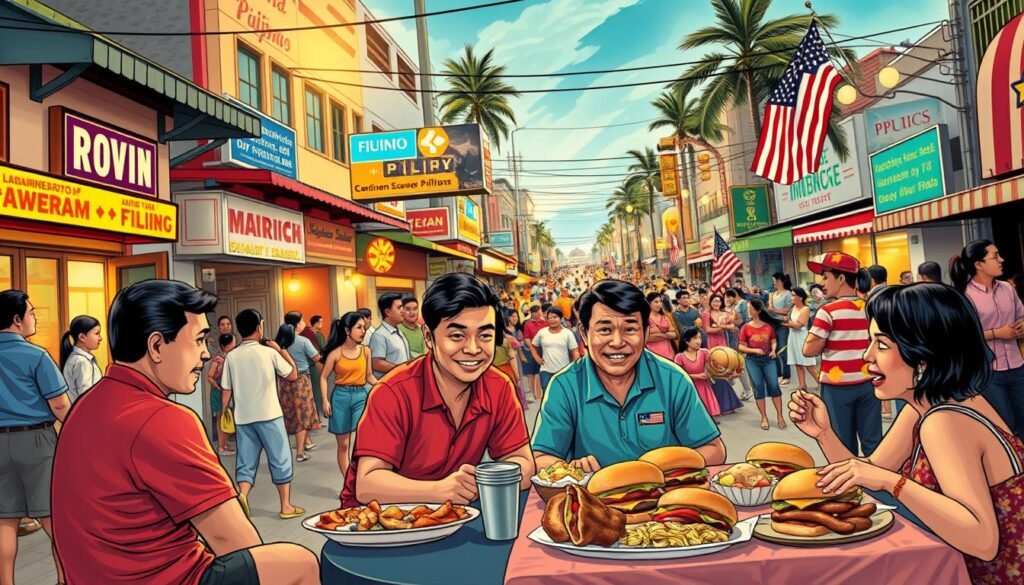
Practical Adaptation Tips
Start by identifying areas where American customs can complement Filipino routines. For example, adopting punctuality in professional settings can enhance efficiency. At the same time, maintain flexibility in social gatherings to preserve Filipino warmth and hospitality.
Use organization systems to track changes. A daily planner can help balance new practices with existing traditions. This approach ensures a smooth transaction between cultures.
Here are some actionable tips:
- Celebrate American holidays like Thanksgiving while incorporating Filipino dishes.
- Practice direct communication in professional settings but use diplomacy in personal interactions.
- Adopt time management techniques while respecting the concept of “Filipino time.”
Step-by-Step Integration Process
Think of cultural adaptation as a transaction with clear steps. First, assess which American traditions align with your values. Next, create a plan to incorporate these practices gradually.
Establish standards for measuring progress. For instance, set goals for punctuality or communication improvements. This structured approach ensures consistency and reduces stress.
Finally, evaluate the impact of these changes. Adjust your plan as needed to maintain cultural balance. This step-by-step process simplifies the adoption of new etiquette elements.
By following these guidelines, you can integrate American traditions into your lifestyle while preserving Filipino heritage. This structured approach fosters cultural understanding and enriches daily life.
Cultural Integration Strategies and Guidelines
Effective cultural integration between American and Filipino practices requires strategic planning and mutual respect. By following structured guidelines, individuals and communities can achieve harmony while preserving their unique identities. This process involves clear steps, leadership, and a focus on development.
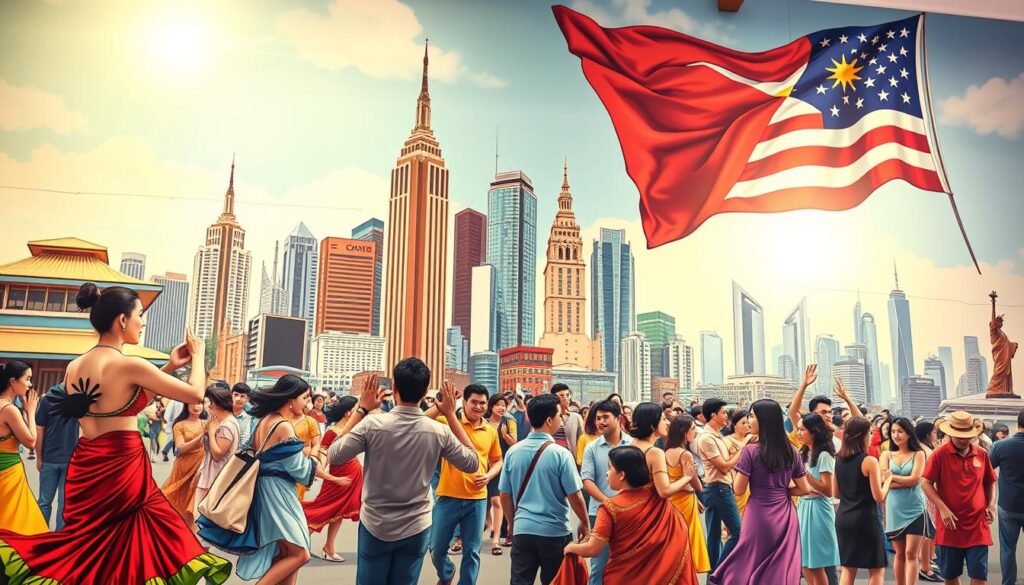
One key strategy is to identify areas where American and Filipino values align. For example, both cultures emphasize respect and hospitality, though their expressions differ. Leaders, or cultural officers, play a crucial role in guiding this process. They can provide direction and foster understanding between communities.
Another important aspect is the concept of cultural transport. This refers to how values and practices can be carried and adapted across societies. For instance, American punctuality can be integrated into Filipino professional settings without disrupting social flexibility. This balance ensures smooth adaptation.
Here are some practical guidelines for cultural integration:
- Establish clear roles for cultural officers to oversee the integration process.
- Focus on development by providing training and resources for individuals and communities.
- Use structured methods, such as workshops or seminars, to facilitate cultural transport.
- Encourage open communication to address misunderstandings and build trust.
By following these strategies, communities can navigate cultural differences with confidence. The guidance of cultural officers ensures that the process remains organized and respectful. This approach not only fosters integration but also strengthens cultural identity.
Cultural integration is a continuous journey. Regular feedback and adjustments are essential to maintain progress. By prioritizing mutual respect and structured methods, American and Filipino practices can coexist harmoniously, enriching both societies.
Navigating Differences in Social Norms
Navigating the differences in social norms between American and Filipino cultures requires a deep understanding of both traditions. These differences often stem from contrasting values, such as individualism versus community focus. By identifying areas of alignment, individuals can foster mutual respect and smoother interactions.

Identifying Areas of Alignment
Despite their differences, American and Filipino cultures share common values like respect and hospitality. For example, both cultures emphasize the importance of family, though their expressions may vary. Recognizing these shared principles can serve as a foundation for cultural integration.
Formal guidelines play a crucial role in managing social etiquette. In the U.S., punctuality is a key norm, while Filipinos value flexibility in social settings. Balancing these practices requires clear order and mutual understanding.
Protecting intellectual property serves as a metaphor for preserving cultural uniqueness. Just as legal frameworks safeguard creative works, cultural practices should be respected and preserved. This approach ensures that traditions remain intact while adapting to new influences.
- Analyze key differences in communication styles—direct versus indirect.
- Identify shared values like respect and hospitality as alignment areas.
- Use formal guidelines to navigate contrasting norms effectively.
- Emphasize the importance of protecting cultural uniqueness, akin to intellectual property.
Practical tips for adapting to differences include active listening and observing local practices. For instance, understanding personal space preferences can prevent misunderstandings. By embracing these nuances, individuals can build stronger cross-cultural relationships.
For more insights on navigating social norms in a new, explore additional resources that highlight the importance of cultural awareness in fostering connections.
Policy and Regulation Influences on Etiquette
Government policies and trade agreements play a crucial role in shaping social etiquette across cultures. These frameworks not only regulate economic activities but also influence how societies adapt to new practices. By understanding these mechanisms, we can better appreciate the connection between policy and cultural behavior.
Government Roles and Trade Agreements
Governments establish policies that impact social norms. For example, trade agreements often include clauses that promote cultural exchange. These agreements facilitate the import of goods, ideas, and practices, which in turn shape local etiquette. A well-structured system ensures that these exchanges are fair and beneficial to all parties involved.
Regulatory bodies also play a key role in maintaining cultural integrity. By enforcing rules on property and intellectual rights, they protect traditional practices while encouraging innovation. This balance is essential for fostering mutual respect and understanding between cultures.
Insights from International Guidelines
International guidelines provide a roadmap for integrating new practices into existing cultural frameworks. These guidelines often emphasize the importance of fairness and transparency. For instance, the system for regulating imports ensures that all parties adhere to agreed-upon standards, fostering trust and cooperation.
Similarly, rules governing property rights in trade agreements mirror the structured nature of social etiquette. Both systems rely on clear guidelines and mutual respect to function effectively. By aligning these practices, societies can achieve a harmonious blend of tradition and modernity.
Here’s a table summarizing key regulatory influences on etiquette:
| Regulatory Practice | Impact on Etiquette |
|---|---|
| Trade Agreements | Facilitate cultural exchange and adaptation. |
| Import Systems | Ensure fair and transparent exchanges of goods and ideas. |
| Property Rules | Protect traditional practices while encouraging innovation. |
By understanding the role of policy and regulation, we can navigate cultural exchanges with greater confidence. For more insights on policy and regulation standards, explore additional resources that highlight the importance of structured frameworks in fostering inclusivity.
The Impact of Globalization on Social Customs
Globalization has reshaped social customs worldwide, blending traditions and creating new norms. This transformation is evident in how American social customs have influenced Filipino etiquette. As globalization facilitates the exchange of ideas and cultures, Filipino customs have integrated elements from American culture, particularly through technology and media, leading to shifts in social behaviors and practices.
International rules and acts have played a significant role in fostering cross-cultural exchanges. Trade agreements and policies often include clauses that promote cultural integration. For example, the intellectual property rights in these agreements ensure that traditional practices are preserved while encouraging innovation.
Digital communication has further accelerated the sharing of traditions. Social media platforms allow people to experience and adopt customs from different cultures. This has led to a more interconnected world where traditions evolve rapidly under the pressure of a global market.
Traditional rules have also transformed to adapt to modern demands. For instance, the Filipino concept of hiya (shame) now coexists with the American emphasis on individualism. This blending of values reflects broader changes in human characteristics influenced by global interactions.
Case studies highlight these shifts. In healthcare, cultural competency training has improved accessibility and effectiveness for diverse populations. Similarly, the globalization’s impact on education systems has introduced new values and practices, enriching local traditions.
Here’s a summary of key changes:
- Globalization has blended American and Filipino social customs.
- International acts and rules facilitate cultural exchange.
- Digital communication accelerates the sharing of traditions.
- Traditional practices evolve under global market pressures.
By understanding these dynamics, individuals can navigate cultural changes with greater awareness and respect. Globalization continues to shape social customs, creating a more interconnected and diverse world.
Case Studies on Integration of American Customs
The integration of American customs into Filipino culture has been a dynamic process, showcasing adaptability and mutual respect. This section explores real-life examples from various sectors, highlighting how these practices have been successfully adopted while preserving Filipino heritage.
Successful Examples from Various Sectors
In the commercial sector, the adoption of American business etiquette has been particularly impactful. For instance, Filipino companies have embraced punctuality and direct communication in professional settings. This shift has improved efficiency and fostered better international partnerships.
Another example is the education system, where American teaching methods have been integrated into Filipino schools. This has enhanced learning outcomes while maintaining the Filipino emphasis on community and respect. The role of bureaus in facilitating these changes has been crucial, ensuring smooth transitions and clear guidelines.
Lessons Learned from Cultural Exchanges
One key lesson is the importance of clearance in cultural integration. Just as trade agreements require clear processes, integrating social norms demands transparency and mutual understanding. This approach minimizes misunderstandings and fosters respect.
Another insight is the value of adaptability. Filipino communities have shown remarkable flexibility in blending American customs with local traditions. This balance ensures that cultural identity is preserved while embracing new practices.
Here are some actionable insights from these case studies:
- Emphasize transparency and clear communication in cultural exchanges.
- Adopt practices that align with local values to ensure smoother integration.
- Leverage the role of bureaus and institutions to facilitate change.
For more insights on cultural integration, explore additional resources that highlight the importance of structured frameworks in fostering inclusivity.
Addressing Challenges in Cultural Adaptation
Adapting to new cultural norms often comes with challenges, much like navigating complex trade agreements. Misunderstandings can arise when practices from one culture are introduced into another, similar to how export procedures can face barriers. These challenges highlight the need for clear communication and mutual respect in both cultural and commercial exchanges.
Common Misunderstandings and Pitfalls
One of the most common pitfalls in cultural adaptation is assuming that practices from one culture will seamlessly fit into another. For example, the American emphasis on punctuality may clash with the Filipino concept of “Filipino time.” This is akin to how trade agreements require careful negotiation to ensure both parties benefit.
Another challenge is the lack of awareness about cultural nuances. Just as a number of export regulations must be understood to avoid delays, cultural practices require thorough understanding to prevent misunderstandings. For instance, direct communication in American culture may be perceived as rude in Filipino settings, where indirect communication is preferred.
Strategies for Overcoming Challenges
To navigate these challenges, it’s essential to adopt strategies that promote understanding and respect. Here are some actionable steps:
- Educate yourself about the cultural practices of the other group. This is similar to understanding trade regulations before engaging in international business.
- Engage in open dialogue to address potential misunderstandings. Clear communication is as crucial in cultural adaptation as it is in export procedures.
- Be flexible and willing to adapt. Just as trade agreements often require compromise, cultural integration demands a balance between traditions.
For more insights on cultural adaptation, explore resources that highlight the importance of structured frameworks in fostering inclusivity.
| Challenge | Parallel in Trade | Solution |
|---|---|---|
| Misunderstanding cultural norms | Lack of knowledge about export regulations | Educate and research thoroughly |
| Clash of communication styles | Differences in trade negotiation practices | Adopt clear and diplomatic communication |
| Resistance to change | Barriers in implementing new trade policies | Promote flexibility and mutual understanding |
By addressing these challenges with thoughtful strategies, individuals and communities can achieve successful cultural adaptation. This approach not only fosters respect but also enriches cultural exchanges, creating a more interconnected world.
Practical How-To: Adapting Social Etiquette
Adapting to new social etiquette practices can feel like navigating a complex port of entry, requiring careful steps and clear guidelines. Whether you’re blending American customs into Filipino traditions or vice versa, the process demands intentionality and respect. This section provides actionable steps and resources to help you adapt seamlessly in both personal and professional settings.
Actionable Steps for Personal and Professional Settings
Start by identifying areas where new practices can complement your existing routines. For example, adopting punctuality in professional settings can enhance efficiency, while maintaining flexibility in social gatherings preserves Filipino warmth. Think of this process as a payment of effort and time—investing in understanding and respect yields long-term benefits.
Here’s a step-by-step guide inspired by procedural frameworks:
- Assess Compatibility: Determine which customs align with your values and lifestyle.
- Create a Plan: Outline how and when to integrate new practices.
- Implement Gradually: Introduce changes in small, manageable steps.
- Evaluate Progress: Regularly assess the impact of these changes and adjust as needed.
Tools and Resources for Ongoing Improvement
Just as an importer relies on tools to streamline processes, you can use resources to enhance your cultural adaptation journey. Here are some recommendations:
- Cultural Training Programs: These provide structured learning and practical insights.
- Language Apps: Improve communication by learning key phrases and cultural nuances.
- Community Groups: Join local or online communities to share experiences and gain support.
For more insights on showing respect towards diverse cultures, explore additional resources that highlight the importance of cultural awareness.
| Step | Description | Tool/Resource |
|---|---|---|
| Assess Compatibility | Identify which customs align with your values. | Cultural Training Programs |
| Create a Plan | Outline how to integrate new practices. | Language Apps |
| Implement Gradually | Introduce changes in small steps. | Community Groups |
| Evaluate Progress | Regularly assess and adjust your approach. | Feedback from Peers |
By following these steps and leveraging the right tools, you can navigate the complexities of cultural adaptation with confidence. Remember, the payment of effort and time is an investment in fostering mutual respect and understanding.
Maintaining Cultural Identity Amid Change
Preserving cultural identity in a rapidly changing world requires both intention and strategy. As global influences grow, the challenge lies in balancing tradition with modernity. This is especially true for Filipino culture, which has been shaped by American social practices while striving to retain its unique heritage.
One effective strategy is to create a list of core values that must remain unchanged. These values serve as a foundation, much like the tariff act provides a framework for trade regulations. By identifying what truly matters, individuals and communities can adapt to new influences without losing their cultural essence.
Balancing Heritage with Modern Influences
Just as a code ensures consistency in legal systems, cultural preservation requires structured approaches. For example, language revitalization programs teach endangered dialects, fostering pride and continuity. Similarly, digital archiving safeguards traditional recipes and practices, ensuring they remain accessible for future generations.
Here are some actionable steps to maintain cultural identity:
- Document traditional practices and values in a list for reference.
- Engage in community programs that promote cultural education.
- Use technology, like 3D scanning, to preserve historical sites and artifacts.
Real-world examples highlight the success of these strategies. In Lu Cam and Phu Vinh, two Vietnamese villages, contrasting approaches to cultural preservation demonstrate the importance of community involvement and tailored policies. Phu Vinh’s success in maintaining its heritage through economic diversification and government support serves as a model for other communities.
“Cultural identity is not static; it evolves while retaining its core essence.”
By adopting these strategies, individuals and communities can navigate the complexities of cultural change. Just as the tariff act regulates trade to protect national interests, cultural preservation ensures that traditions remain vibrant and relevant in a globalized world.
Conclusion
The fusion of American and Filipino social practices highlights the importance of cultural adaptability in a globalized world. Throughout this article, we’ve explored how American customs have influenced Filipino etiquette, creating a unique blend of traditions. Learning and adapting these practices fosters personal and professional growth, much like the structured processes in an office ensure efficiency.
Just as imported goods undergo careful clearance and verification, cultural elements require thoughtful integration. Well-regulated processes, whether in trade or social norms, ensure smooth transitions and mutual respect. By embracing this approach, individuals can navigate cultural exchanges with confidence.
Continued exploration and adaptation are key to thriving in a diverse world. Let this guide inspire you to blend traditions thoughtfully, preserving cultural identity while embracing new influences.
FAQ
How have American social customs influenced Filipino etiquette?
American social customs have introduced new practices, such as casual greetings and punctuality, which have blended with traditional Filipino values like respect and hospitality.
What are the core cultural values in Filipino etiquette?
Filipino etiquette emphasizes respect for elders, close family ties, and a strong sense of community, often referred to as “pakikisama.”
How can one adapt American traditions into Filipino lifestyles?
Start by identifying shared values, such as family and respect, and gradually incorporate practices like celebrating Thanksgiving or adopting informal communication styles.
What are the key differences between American and Filipino social norms?
Americans often prioritize individualism and direct communication, while Filipinos value collectivism and indirect, harmonious interactions.
How does globalization impact social customs in the Philippines?
Globalization has introduced diverse cultural practices, leading to a blend of traditional Filipino etiquette with modern, Westernized behaviors.
What challenges arise when adapting to American social customs?
Common challenges include balancing traditional values with new practices and overcoming cultural misunderstandings in communication styles.
How can individuals maintain their cultural identity while adapting to new customs?
By staying rooted in core values like family and respect, individuals can integrate new practices without losing their cultural heritage.
What role do government policies play in shaping social etiquette?
Policies on trade, education, and cultural exchange influence how social norms evolve, often blending local traditions with international practices.
Are there successful examples of integrating American customs into Filipino culture?
Yes, practices like celebrating Halloween and adopting Western business etiquette have been successfully integrated while preserving Filipino traditions.
What resources can help in adapting to new social norms?
Cultural workshops, online guides, and community programs provide valuable tools for understanding and integrating new customs effectively.
Source Links
- Colonial Legacies: Spanish, American, and Japanese Influences on Filipino Culture and the Modern Employee
- Customs, greetings and etiquette – getting it right in the Philippines
- Filipino vs. American Culture: Work Ethic & Traditions 2025
- Language, Culture, Customs and Etiquette
- Filipino – Etiquette
- CUSTOMS, ETIQUETTE AND MANNERS IN THE PHILIPPINES
- Immigration to the United States, 1851-1900 | Rise of Industrial America, 1876-1900 | U.S. History Primary Source Timeline | Classroom Materials at the Library of Congress | Library of Congress
- Americanization
- A Brief History of the American Dream | George W. Bush Presidential Center
- Filipino Customs and Etiquette
- Philippines – Culture, Diversity, Traditions | Britannica
- Customs and etiquette in Philippines
- American Culture: Values, Customs, & More in the USA
- American – Core Concepts
- Culture of the United States
- Social Norms
- Frontiers | Culture and Social Norms: Development and Application of a Model for Culturally Contextualized Communication Measurement (MC3M)
- The Role of Customs in Global Trade Today
- Exploring Customs and Their Relevance
- How Traders, Travelers and Colonization Shaped Filipino Cuisine
- From Indigenous Roots to Global Fusion: The Evolution of Filipino Culture and Its Impact on Today’s Workforce
- Indigenous Peoples in the Philippines: Continuing Struggle
- How to Facilitate Seamless Cultural Integration After a Business Acquisition
- What are the key strategies for successful cultural integration in diverse workplaces?
- Cultural Integration in UAE Workplaces: Strategies for Thriving in Diversity
- Navigating Social Norms And Customs – FasterCapital
- Cultural Expectations: How Social Norms Influence Our Choices
- Regulation | Definitions, Theoretical Approaches, & Facts | Britannica
- Government Regulations: Do They Help Businesses?
- Frontiers | Cultural regulation of emotion: individual, relational, and structural sources
- The Importance of Understanding Social and Cultural Norms in Delivering Quality Health Care—A Personal Experience Commentary
- The role of customs in the system of social norms
- 943-Manuscript-3734-1-18-20190714
- 構成案(やり直し)
- What history tells us about assimilation of immigrants
- Cultural Adaptation of Interventions in Real Practice Settings
- Main Section | Community Tool Box
- Issues and Challenges in the Design of Culturally Adapted Evidence-Based Interventions
- How to adapt communication for cultural differences, and why is it so important?
- Top Ten Tips for… Effective Cross-Cultural Communication
- The Challenges of Adapting to a New Culture: How to Overcome Them- – Study And Work Abroad
- Cultural Preservation: Ensuring Our Legacy Endures
- FIRST PERSON | It’s hard to maintain cultural identity when you move out of the family home | CBC News
- Conclusion – Custom as a Source of Law
- No title found
- Conclusion: customary law in a globalizing culture (Chapter 12) – The Role of Customary Law in Sustainable Development

